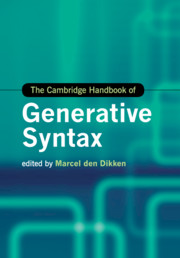
-
Select format
-
- Publisher:
- Cambridge University Press
- Publication date:
- August 2013
- July 2013
- ISBN:
- 9780511804571
- 9780521769860
- 9781108744362
- Dimensions:
- (247 x 174 mm)
- Weight & Pages:
- 1.9kg, 1164 Pages
- Dimensions:
- (244 x 170 mm)
- Weight & Pages:
- 1.984kg, 1164 Pages
You may already have access via personal or institutional login
Book description
Syntax – the study of sentence structure – has been at the centre of generative linguistics from its inception and has developed rapidly and in various directions. The Cambridge Handbook of Generative Syntax provides a historical context for what is happening in the field of generative syntax today, a survey of the various generative approaches to syntactic structure available in the literature and an overview of the state of the art in the principal modules of the theory and the interfaces with semantics, phonology, information structure and sentence processing, as well as linguistic variation and language acquisition. This indispensable resource for advanced students, professional linguists (generative and non-generative alike) and scholars in related fields of inquiry presents a comprehensive survey of the field of generative syntactic research in all its variety, written by leading experts and providing a proper sense of the range of syntactic theories calling themselves generative.
Reviews
‘This magisterial overview of the historical development and current state of generative syntax is balanced, wide-ranging, intermittently controversial, always constructive, and consistently useful to neophyte and seasoned researcher alike.’
Neil Smith - Professor Emeritus of Linguistics, University College London
Contents
Metrics
Full text views
Full text views help Loading metrics...
Loading metrics...
* Views captured on Cambridge Core between #date#. This data will be updated every 24 hours.
Usage data cannot currently be displayed.
Accessibility standard: Unknown
Why this information is here
This section outlines the accessibility features of this content - including support for screen readers, full keyboard navigation and high-contrast display options. This may not be relevant for you.
Accessibility Information
Accessibility compliance for the PDF of this book is currently unknown and may be updated in the future.


